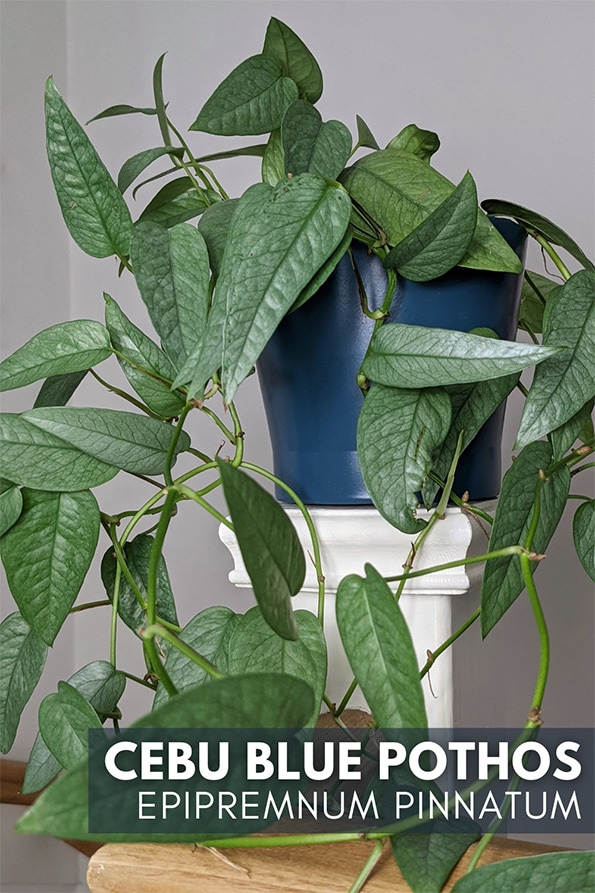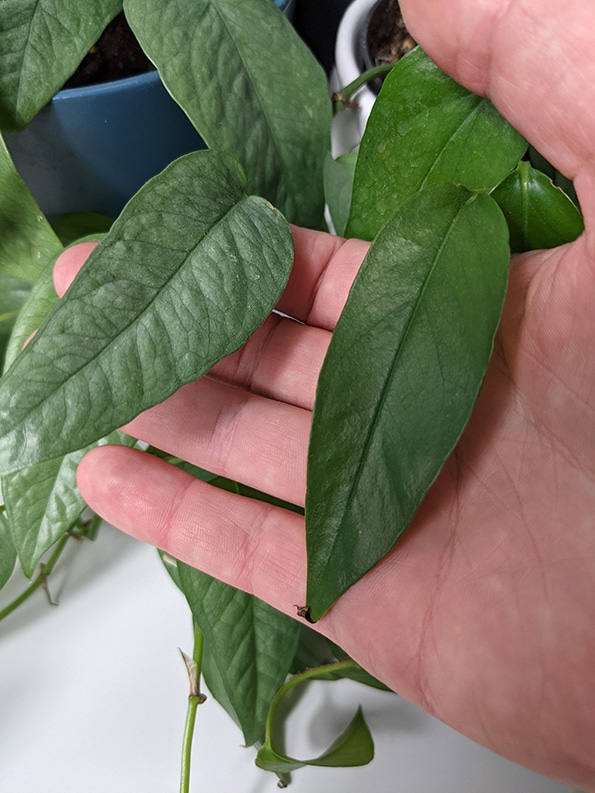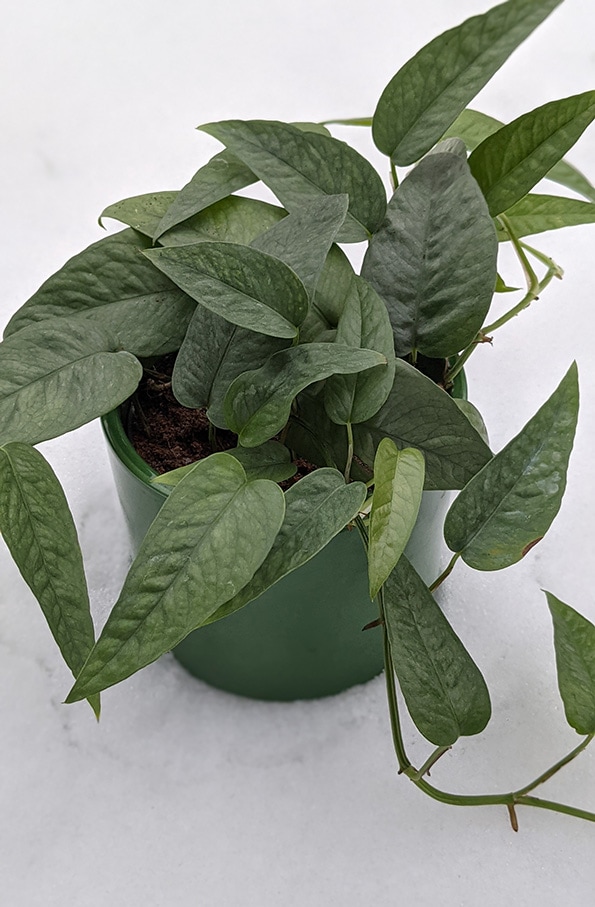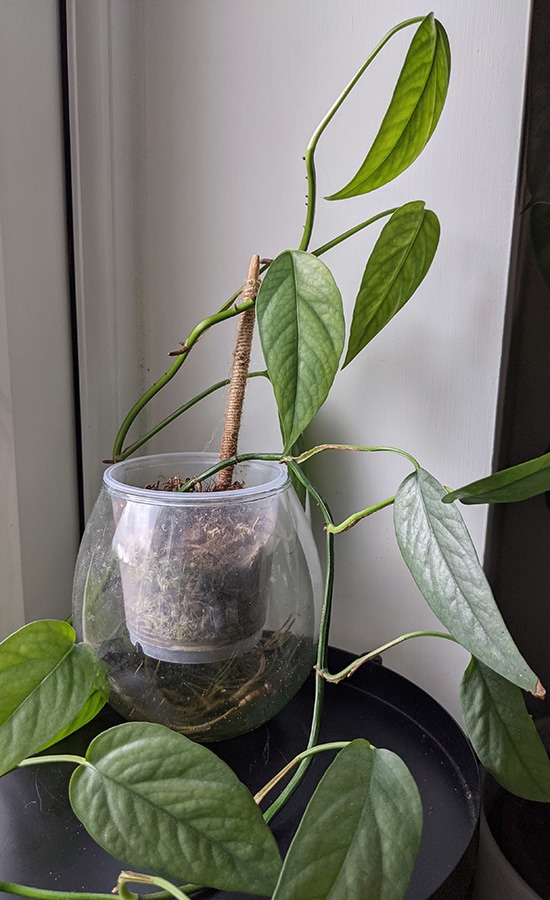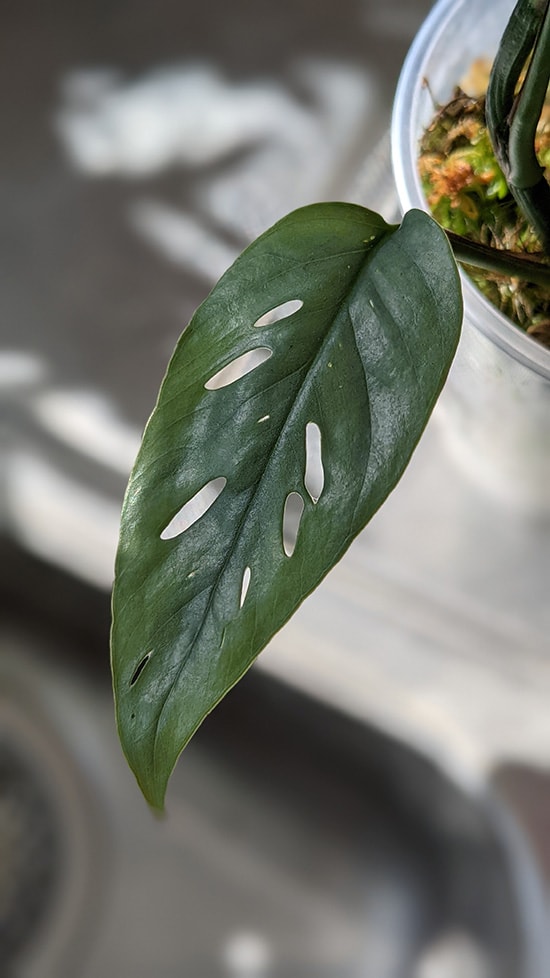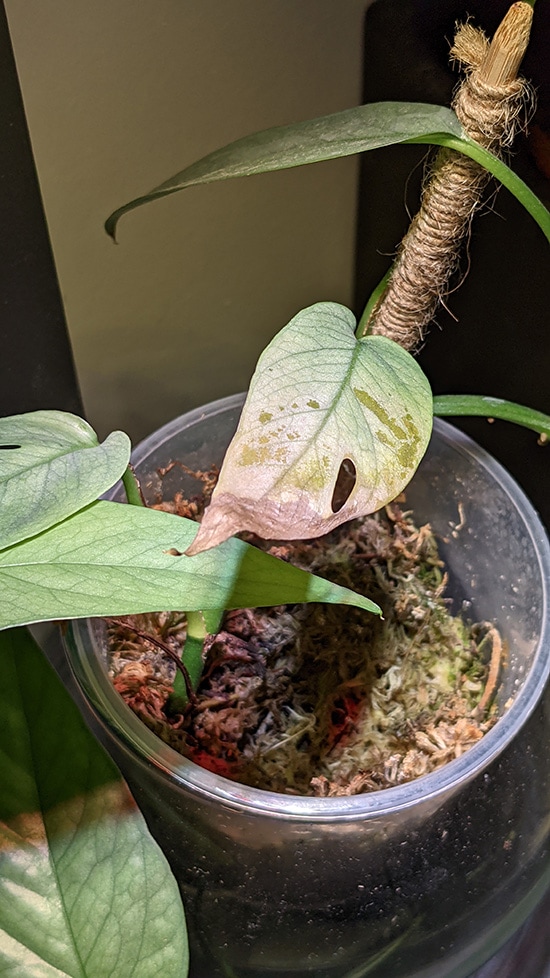The Epipremnum pinnatum 'Cebu Blue,' more commonly known as the Cebu Blue Pothos, is a striking houseplant desired for its unique blue-green foliage with a silvery iridescence.
Like most "Pothos" plants, it's renowned for its easy care and adaptability to various indoor conditions. It can be allowed to trail and sprawl or trained to climb up a moss pole for an upright aesthetic.
With its silvery-blue leaves and easygoing nature, this is an excellent plant for a hanging basket, or it can be allowed to cascade over a shelf edge. The trailing vines can also be trained to grow up a moss or coconut coir totem if you want to to grow larger leaves.
The Cebu Blue is a product of the recent houseplant boom and was a highly sought after alternative to the more familiar Pothos (Epipremnum aureum). Prices were initially very high, but today you can pick up small plants or cuttings for a few dollars and larger plants are priced similarly to the regular Pothos.
How do you pronounce Epipremnum pinnatum Cebu Blue correctly? Say:
eh-puh-PREM-num pin-NAY-tum SEH-boo bloo
Although it's often called the Cebu Blue "Pothos", it's actually a different species from the usual Pothos plants. The true Pothos is Epipremnum aureum, which has thicker stems and the leaves have a more rounded appearance and are less textured than the Cebu Blue.
Instead, the Cebu Blue is a variety of Epipremnum pinnatum native to Cebu Island in the Philippines. It has silvery blue leaves with a slightly glossy and textured look. This helps reflect light and shows off the unusual coloring.
Young plants have relatively small leaves that look graceful hanging or trailing down. They remind me a little of Satin Pothos (Scindapsus Pictus), so if you're a fan of those plants you should get on well with the Cebu Blue.
Two Epipremnum pinnatum plants. On the left is the Cebu Blue variety and on the right is the original plant which does not have the silver or blue-green colorings.
Mature plants growing up a climbing support like a moss stick, will grow huge leaves that lose some of the silvery blue and tend to have darker greens in the leaf color. But in return you will often get attractive fenestrations with splits and holes over the larger leaves.
Did You Know?
The common name "Cebu Blue" originates from its natural habitat on the tropical island of Cebu in the Philippines. "Blue" refers to the distinctive blue sheen on its leaves.
It's a versatile plant with a few distinctive looks so you can choose how it will look and grow in your home. It's also reasonably adaptable and can cope with several different growing conditions.
Even beginners should be able to grow these plants with good success. My full care guide, which you can read below, will help with this.

Hi, I'm Tom!
If you're like me and enjoy the challenge of growing houseplants and getting them to thrive, then Ourhouseplants can help. This website shares my knowledge and years of growing plants and provides (hopefully) helpful advice on properly caring for your indoor plant friends.
The Cebu Blue Pothos is looking for a bright light location in your home. It can take some full sun (early morning / late evening), but if the sun is too intense, the leaves can become washed out and scorched.
Somewhere set back at least a few feet from a window will in most cases be perfect.
Although it's not ideal, Cebu Blue will tolerate lower light conditions, such as those found in offices or rooms with moderate lighting. Although it usually keeps the silvery blue coloring, the growth will slow down in lower light, and the plant may become leggy over time.
I've found this to be a moderately thirsty houseplant. It will dry out reasonably fast even if the light levels are on the lower side.
Like many plants, Cebu Blue is susceptible to yellowing leaves and root rot if overwatered excessively. Ensure that the pot has drainage holes and that excess water can freely drain away. Less water is needed over winter so cut back at this time of the year.
It does best with a period of drying out between waterings. As a general rule aim to allow the top inch or two (2.5 to 5 cm) of soil to dry out between each watering. It can also cope with drying out completely for a few days. If this ever happens the leaves start to look washed out and can curl and hang slightly.
Tropical plants prefer higher humidity, and the Epipremnum pinnatum and its varieties are no exception. However some are still pretty tolerant and the Cebu Blue fits into this group.
Unless you have extremely low humidity levels you should be able to grow this plant wherever you want without the aid of any special humidity boosters.
Cebu Blue plants don't require heavy feeding. During the growing season (spring and summer), fertilize once a month at the most. Reduce or stop feeding during the dormant season (fall and winter).
Ideally Cebu Blue plants prefer warmer temperatures somewhere between 65°F (18°C) to 85°F (30°C).
They can cope with cooler temperatures if needed but they wouldn't choose this, if they had a choice. The plant will stop growing when temperatures fall below 65°F (18°C) and will suffer damage when the temperature drops closer to freezing.
These are popular houseplants and are sold all year round. If you need to repot it during winter then go for it. But keep it outside for the shortest time possible to prevent cold air from damaging it.
The roots are quite superficial compared to other houseplants and it will take a while before they outgrow a container and want to be moved on. Younger plants will need annual repotting until established. But as soon as they get to a decent size you may only need to repot every two or three years (maybe longer in some cases).
When you do it, choose a pot slightly larger than the current one. This helps prevent overwatering from becoming a problem while the roots grow into the space a new planter provides.
Conventional wisdom says you should do it during Spring. But I repot my houseplants whenever they need it (and I'm in the mood to do it!). You can repot in winter if you prefer, but obviously only keep your plant outside for a short a time as possible.
They will grow in a wide range of potting mixes and soils. The best balance for a healthy growing plant, will be some kind of well-draining potting mix. This mix should hold water but also allow some to drain through to prevent overwatering and provide air pockets for the roots to breathe.
To achieve this, you can use a standard houseplant potting mix or create your own mix by combining equal parts potting soil with perlite (or other inorganic materials, to produce the "free draining effect").
If you want to propagate these plants then stem cuttings are the way to go. I'm over on YouTube now, so I'll do a video for these plants in the future. In the meantime if you want a visual guide watch me propagate the Satin Pothos which uses the exact same method.
If reading is your thing, then here is what you should do.
Take a Cutting: Using scissors or pruning shears, make a clean cut just below a node (the point where a leaf meets the stem). Nodes are essential because this is where roots will develop. You're unlikely to get results by just using a leaf.
Remove Lower Leaves: If you have a lot of leaves on the cutting then remove the lower leaves, leaving just a few at the top. This will help prevent the leaves from rotting when submerged in water or buried in soil.
Option 1 - Rooting in Water. Place the cutting in a jar or glass of water, ensuring that the cut end is submerged, but any leaves are above the water. Place the jar in a location with indirect sunlight and change the water every week or so to prevent stagnation.
Option 2 - Rooting in Soil. You can plant the cutting directly into a small pot filled with well-draining potting mix. Make a hole in the soil with a pencil or your finger, insert the cutting, and gently firm the soil around it.
Option 3 - Rooting in Sphagnum Moss. You can root them in Sphagnum Moss too (follow the same method as rooting in soil). You can see this happening in the photo below.
Sphagnum Moss dries out faster than soil, so you may need to water it a little more often.
Epipremnum Cebu Blue can be grown in Sphagnum Moss or water for a few years if you want to show them off in unusual planters like this. However they will need potting up into a proper mix eventually.
Provide warmth, light and then wait for roots to develop. Remember these plants will only grow when daytime temperatures are consistently warm. If they get this, then roots should start to develop within a few weeks. You can leave them like this for months (or longer!) before moving them into their final potting mix.
When conditions are good, the Cebu Blue Pothos is considered a moderate to fast-growing plant. This will mean giving it decent light levels and warm temperatures.
The growth rate can slow down in lower light conditions or during the plant's dormant period, typically in the fall and winter months.
With maturity come holes and splits in the leaves known as fenestrations. If this plant is given a moss pole to climb, the leaves and holes will get a lot bigger on future leaves. If you leave them to trail with no support they will be unlikely to get bigger and stay in the juvenile phase.
Top Tip
Regular pruning and training can help control the size and shape of the Cebu Blue Pothos plant. Trimming back excessively long vines and encouraging branching can help maintain a more compact and bushy growth habit.
The size of a Cebu Blue Pothos plant can vary depending on various factors such as how you choose to grow it, care provided, and available space.
If you keep it in a small pot and allowed to trail, although attractive, it won't reach its full potential. If you keep potting it up every few years into a larger container and growing it up a moss pole, it can become 2 meters (6.5 feet) or more.
The plants can flower, but it's very rare indoors. None of my plants have ever produced blooms and I can't recall seeing anyone posting about it online. If you know something I don't, please share in the comments.
Cebu Blue plants are typically safe around pets, but they contain compounds that can irritate the mouth and cause mild gastrointestinal upset. As any pet parent knows cleaning up "messes" is one of the worst part of the job. So if you have a pet that's known to eat your plants, keep the plants out of reach.
No fenestrations on Cebu Blue plant.
The primary reason for lack of fenestrations is down to immaturity. Only established and aging plants will grow leaves with splits in their leaves.
Maturity only occurs when the following happens.
Yellow Leaves.
Older leaves will sometimes go yellow, and this is normal and can't be prevented. Sometimes lots of leaves will start going yellow and in most cases this is going to be down to overwatering or excessive light levels.
Bright indirect light or partial shade should help to avoid this damage which is typically caused by very bright light, or in this case, being too close to a grow light.
If it is overwatering, this will be you final warning before root rot sets in and you lose the whole plant. So ease back on the water and wait longer between waterings in the future, giving the potting mix time to dry out more.
Brown Tips / Edges.
This can be caused by any of the common reasons houseplants tend to get brown leaves. Namely, very low humidity, underwatering and overwatering (although this usually causes more black rather than brown edges).
Sometimes, brown tips can be caused by nutrient deficiency, pests, or disease. However, these last two are pretty unlikely causes.
Water Dripping from Leaves.
If water drips from the leaves of your Cebu Blue (especially in the mornings) it's likely due to a phenomenon called guttation. Guttation occurs when plants exude excess water through specialized structures called hydathodes which is a type of pore.
It almost only ever happens when there is quite a lot of water around the roots of the plant. It doesn't necessarily mean you're overwatering (although you might be!) but it's often an early warning sign you're getting close. Ease up slightly on the watering, or rather, how much you provide when you do water it.
Blue Coloring is not Present.
Like many other Pothos plants, the markings / colorings are pretty stable, even in low light. However it's less prevalent on mature leaves (for unknown reasons).
So as a general rule, juvenile foliage will have more of the familiar blue color whereas mature leaves will get less. But in return you will have larger leaves with more fenestrations.
